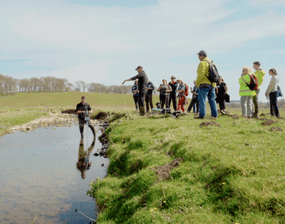Rising waters | Rooted solutions
Measuring impact: How monitoring shapes the future of natural flood management (NFM)

Monitoring a decision-making tool that can shape investment, land management and long-term flood resilience. Our latest short film puts this idea into focus.
Monitoring is often treated as a technical box to tick, but it is far more than that. It is a decision-making tool that can shape investment, land management and long-term flood resilience.
Ousewem’s latest short film, Measuring impact: How monitoring shapes the future of natural flood management (NFM), puts this idea into focus. It asks what kind of evidence we really need to track impact, build confidence, and scale up what works.
As Rachel Flood, Ousewem project manager, explains:
Monitoring isn’t just about gathering data, it’s about building confidence. We need to understand what works, where, and why. That insight is vital not only for landowners and delivery teams, but also for funders and policymakers. At Ousewem, we’re working to make monitoring more meaningful, so it supports better decisions across the board.
Filmed on location at the Yorkshire Natural Flood Management (NFM) Community of Practice (CoP) Monitoring Skill Share event and in the upper catchments of the River Nidd, specifically Crimple Beck upstream of Burn Bridge, the video brings together perspectives from farmers, academics, and project partners. It shows how different types of monitoring all have a role to play.
Farmer Rob Ruddock, who features in the film alongside Joanna Olner, shares:
The monitoring will hopefully show the benefits. Its just the case that you need the monitoring to convince partners to get involved.
The film raises key questions for those funding, delivering, or assessing NFM:
- What kind of data do we need to shape the future of NFM?
- How can we ensure monitoring provides useful insights for both funders and landowners?
- Where is the balance between scientific rigour and practical, scalable approaches?
A tool for decision-makers
The right monitoring can:

- improve confidence in NFM as a viable solution
- influence green investment and national policy
- provide meaningful feedback to landowners and delivery partners
But as Ousewem’s work has shown, there are still challenges. Funders and policymakers often see monitoring as an add-on rather than a core part of the NFM lifecycle. Landowners may be asked to record data that is too complex or not practically useful. And despite growing interest in green finance, many investors still want proof that NFM delivers measurable returns – but it's not always clear what that ‘proof’ looks like.
Bridging the gap
Ousewem is working with the University of York and other partners to develop smarter, more joined-up monitoring and modelling guidance.
The aim is to:
- identify which metrics best capture NFM benefits
- match monitoring methods to investor and policymaker needs
- champion low-cost, practical options that still offer valuable insight
- facilitate better conversations between funders, landowners and researchers
Part of a wider story
This is the fourth video in the Ousewem series. Watch the full Ousewem series:
- Overcoming challenges in natural flood management (NFM): Insights from North Yorkshire land managers (YouTube)
- NFM tools: modelling, theory and practice (YouTube)
- Strength in partnerships: how collaboration drives natural flood management (YouTube)
- Ousewem’s story so far: turning data into action for flood resilience (YouTube)
All 4 are available on our YouTube channel.
Together, they highlight the people, places, and partnerships shaping a more resilient future for York and North Yorkshire.
Also see

